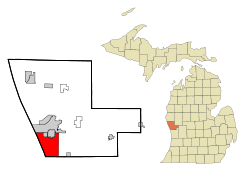Norton Shores, Michigan
Norton Shores, Michigan | |
|---|---|
 Location of Norton Shores, Michigan | |
| Country | United States |
| State | Michigan |
| County | Muskegon |
| Area | |
| • Total | 24.5 sq mi (63.4 km2) |
| • Land | 23.2 sq mi (60.2 km2) |
| • Water | 1.2 sq mi (3.2 km2) |
| Elevation | 614 ft (187 m) |
| Population (2000) | |
| • Total | 22,527 |
| • Density | 969.2/sq mi (374.2/km2) |
| Time zone | UTC-5 (Eastern (EST)) |
| • Summer (DST) | UTC-4 (EDT) |
| ZIP code | 49441 |
| Area code | 231 |
| FIPS code | 26-59140Template:GR |
| GNIS feature ID | 0633743[1] |
| Website | http://www.nortonshores.org/ |
Norton Shores is a city in Muskegon County in the U.S. state of Michigan. The population was 22,527 at the 2000 census.
Overview
Norton Shores is located on the shores of Lake Michigan in Muskegon County. The community of 22,527 residents encompasses over 24 square miles including Mona Lake and Black Lake as well as Hoffmaster State Park.
Norton Shores might best be described as a suburban environment with a balance of industrial and commercial development. It has also led the county in residential construction permits for the past five years. The city offers educational opportunities from the Mona Shores Public Schools to Muskegon Community College, Baker College and Grand Valley State University.
History
The Chippewa, Potawatomi and Ottawa Indians for hundreds of years occupied the wilds of Western Michigan. The Native American tribes were very protective of the natural environment Mother Nature put on this earth. When the immigrants arrived they found openings in the forest made by the Native Americans, which were used to raise food.
Norton Township was originally organized in 1845 by settlers of the village of Mill Point (now Spring Lake). The township was named in honor of Col. Amos Norton, a Canadian patriot who was implicated in the rebellion of 1837.
Norton Township was part of Ottawa County and also included the Townships of Fruitport and Sullivan. In 1855 Spring Lake Township was detached from Norton and organized as a township in Ottawa County. Norton Township was separated from Ottawa County in 1859 and became a part of Muskegon County. The population of Norton Township in 1860 was 197 and in 1864 was 229.
In 1847 the first sawmill in Norton Township was built. It was known as Robinson's Mill and was located at the head of Black Lake (now known as Mona Lake).
In 1850, Ira Porter arrived at Mona Lake. He operated Porter Sawmill and a fruit farm. One of the largest fruit farms in Norton Township was operated by G. N. Cobb who also operated a box factory for fifteen years beginning in 1869. With the closing of the sawmills and the box factory, residents turned to raising fruit which became a very profitable industry. Boats would enter Lake Harbor and make a trip around the lake picking up crates of berries at the docks of the growers. They would then return to Lake Michigan with their cargo and transfer it to large steamers bound for Chicago.
Thanks to the Norton Township Volunteer Fire Department and the cooperation of the Norton Township Board, action was taken to incorporate Norton Township into a Home Rule City. An election to determine if Norton Township should be incorporated into a Home Rule City passed by a two to one margin and nine charter commissioners were elected to draw up the first City Charter which was adopted on April 16, 1968.
Geography
According to the United States Census Bureau, the city has a total area of 24.5 square miles (63.4 km²), of which, 23.2 square miles (60.2 km²) of it is land and 1.2 square miles (3.2 km²) of it (4.99%) is water.
Demographics
As of the censusTemplate:GR of 2000, there were 22,527 people, 8,996 households, and 6,396 families residing in the city. The population density was 969.2 per square mile (374.3/km²). There were 9,679 housing units at an average density of 416.4/sq mi (160.8/km²). The racial makeup of the city was 94.63% White, 1.63% African American, 0.73% Native American, 0.84% Asian, 0.01% Pacific Islander, 0.63% from other races, and 1.53% from two or more races. Hispanic or Latino of any race were 2.69% of the population.
There were 8,996 households out of which 30.7% had children under the age of 18 living with them, 60.0% were married couples living together, 8.1% had a female householder with no husband present, and 28.9% were non-families. 24.9% of all households were made up of individuals and 11.7% had someone living alone who was 65 years of age or older. The average household size was 2.48 and the average family size was 2.97.
In the city the population was spread out with 24.8% under the age of 18, 6.6% from 18 to 24, 25.8% from 25 to 44, 25.5% from 45 to 64, and 17.3% who were 65 years of age or older. The median age was 41 years. For every 100 females there were 94.3 males. For every 100 females age 18 and over, there were 91.2 males.
The median income for a household in the city was $45,457, and the median income for a family was $53,447. Males had a median income of $38,115 versus $26,728 for females. The per capita income for the city was $22,713. About 3.7% of families and 5.3% of the population were below the poverty line, including 6.3% of those under age 18 and 3.0% of those age 65 or over.

